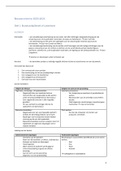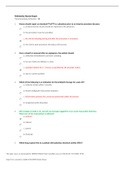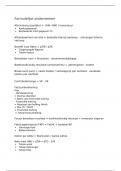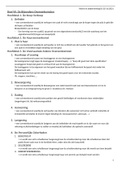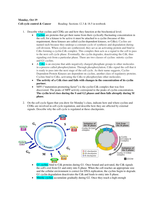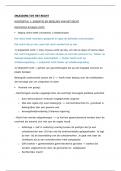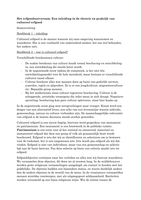Exam 2 Learning Outcomes
Learners will demonstrate knowledge of ectopic pregnancy S&S and management of patients with this dx
o Ectopic pregnancy is an implantation of a fertilized ovum in an area outside the uterine cavity.
Although implantation can occur in the abdomen or cervix, 97% of ectopic pregnancies occur in
the fallopian tube (Cunningham et al., 2014). Fig. 10.2 shows the common sites of ectopic
implantation
o The classic signs of ectopic pregnancy include the following:
Missed menstrual period
Positive pregnancy test
Abdominal pain (Unilateral Stabbing)
Vaginal “spotting”
More subtle signs and symptoms depend on the site of implantation. If implantation
occurs in the distal end of the fallopian tube, which can contain the growing embryo
longer, the woman may at first exhibit the usual early signs of pregnancy and consider
herself to be normally pregnant. Several weeks into the pregnancy, intermittent
abdominal pain and small amounts of vaginal bleeding occur, and initially this could be
mistaken for threatened abortion. Because routine ultrasound examination in early
pregnancy is common, however, it is not unusual to diagnose an ectopic pregnancy before
onset of symptoms.
Hypovolemic shock (acute peripheral circulatory failure from loss of circulating blood) is
a major concern because systemic signs of shock may be rapid and extensive without
external bleeding.
o Diagnosis
The combined use of transvaginal ultrasound examination and determination of beta-hCG
usually results in early detection of ectopic pregnancy. An abnormal pregnancy is
suspected if beta-hCG is present but at lower levels than expected. If a gestational sac
cannot be visualized when beta-hCG is present, a diagnosis of ectopic pregnancy may be
made with great accuracy. Visualization of an intrauterine pregnancy, however, does not
absolutely rule out an ectopic pregnancy. A woman may have an intrauterine pregnancy
and concurrently have an ectopic pregnancy. Laparoscopy (examination of the peritoneal
cavity by means of a laparoscope) occasionally may be necessary to diagnose rupture of
an ectopic pregnancy. A characteristic bluish swelling within the tube is the most
common finding.
o Management
Management of tubal pregnancy depends on whether the tube is intact or ruptured.
If mother is RH- RHoGAM
Unruptured
Medical management with methotrexate may be an option to surgery in the
woman with an early ectopic pregnancy if the tube is unruptured The goal of
medical management is to preserve the tube and improve the chance of future
fertility. Methotrexate, a chemotherapeutic agent, is a folic acid antagonist that
inhibits cell replication and therefore targets rapidly dividing cells, such as the
trophoblastic cells in early pregnancy. It is approximately 90% effective in
treating ectopic tubal pregnancy Successful medical management is associated
with small ectopic size, low initial serum beta-hCG levels, and absent fetal
cardiac activity. It may be given in a single dose or multiple dose protocol The
multiple dose protocol may be more successful, but the single dose protocol is
less complex, is less expensive, and does not require as much follow-up as the
multiple dose protocol The single dose protocol calls for 50 mg/m2 of body
surface area. Follow-up hCG levels are required on days 4 and 7 and then
weekly until hCG is not detectable in the woman’s blood.
Surgical management of a tubal pregnancy that is unruptured may involve a
linear salpingostomy, removal of the ectopic pregnancy from the tube in an
effort to salvage the tube or a salpingectomy—removal of the tube
Ruptured
, When ectopic pregnancy results in rupture of the fallopian tube, the goal of
therapeutic management is to control the bleeding and prevent hypovolemic
shock. Ruptured ectopic pregnancy is a major emergency. When the woman’s
cardiovascular status is stable, salpingectomy with ligation of bleeding vessels
may be require
o Considerations
Nursing care focuses on prevention or early identification of hypovolemic shock, pain
control, and psychological support for the woman who experiences ectopic pregnancy.
Nurses monitor the woman for signs and symptoms that suggest tubal rupture or bleeding
(e.g., pelvic, shoulder, or neck pain; dizziness or faintness; increased vaginal bleeding).
Nurses administer ordered analgesics and evaluate their effectiveness so pain can be
adequately controlled. The nurse administers Rh immune globulin to Rho(D)-negative
women.
If the plan of care includes methotrexate, the nurse should be aware that methotrexate is a
chemotherapeutic agent. Facility protocols for chemotherapy should be followed,
including appropriate personal protective equipment (double glove) and verification of
patient name, medication, and dosage by another nurse. Air should not be expelled from
the syringe, because it could aerosolize the medication. The woman should be taught that
her urine is considered toxic for 72 hours. She should be careful to avoid getting urine on
the toilet seat. The toilet should be flushed twice with the lid closed when she voids.
Additional patient teaching includes adverse side effects such as nausea and vomiting and
the importance of informing the health care team of any physical changes. Transient
abdominal pain occurs during methotrexate therapy, probably because of expulsion of the
products of conception from the tube. The woman also should be instructed to refrain
from drinking alcohol (which decreases the effectiveness of methotrexate), taking
vitamins that contain folic acid, using nonsteroidal anti-inflammatory drugs, and having
sexual intercourse until beta-hCG is not detectable in her blood. If the treatment is
successful, this hormone disappears from plasma within 2 to 3 weeks. Maintaining
follow-up appointments is essential to identify whether the hCG titer becomes negative
and remains negative. Continued presence of hCG in the serum requires follow-up to
identify whether the ectopic pregnancy is still present.
Nurse’s roles in assisting during cerclage along with knowledge of what the procedure entails and why is
performed
o Encircling the cervix with sutures to prevent recurrent spontaneous abortion caused by early
cervical dilation. (Usually at 11-15 weeks gestation)
o Removed prior to labor
o Short Cervix usually a cause – less 25mm leads to cervical incompetence
o Recurrent spontaneous abortion may be caused by cervical incompetence, also called cervical
insufficiency, an anatomic defect that results in painless dilation of the cervix in the second
trimester. In this situation, a cerclage procedure—suturing of the cervix to prevent early dilation—
may be performed. The cerclage is most likely to be successful if done before much cervical
dilation or bulging of the membranes through the cervix has occurred. Sutures may be removed
near term in preparation for vaginal delivery, or they may be left in place if a cesarean birth is
planned. Prophylactic antibiotics are ordered if the woman is at increased risk for infection.
Preterm labor may still occur after the fetus is viable.
o Bed rest recommended
Give examples of foods that are rich in folic acid
o 30mg iron daily prenatal (vit c assist in absorption of iron)
o Increase in folic acid of 600 mcg per day is recommended
o Fruits, Veggies, Nuts and Seeds
Recognize the blood tests done for a patient diagnosed with preeclampsia
o Preeclampsia occurs after 20 weeks of pregnancy
Mild BP > 140/90
Can also have proteinuria (1+ or 2+)



